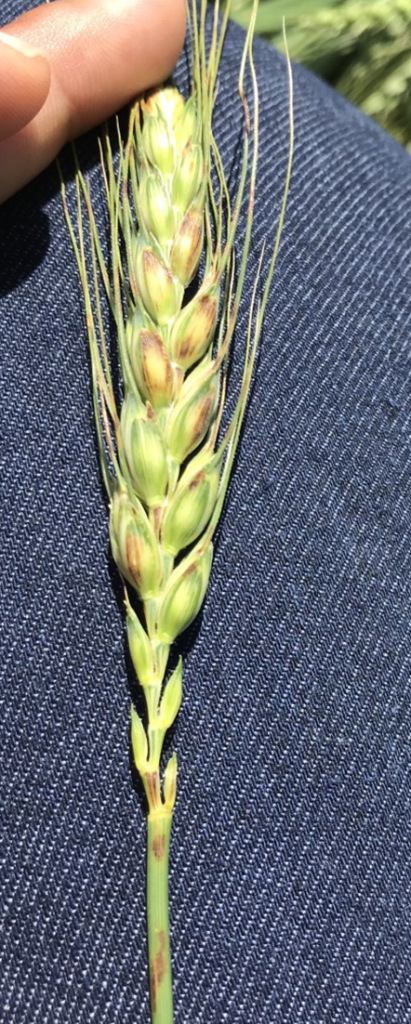Wheat Disease Update – 19 May 2022
Categories: Disease updates
Meriem Aoun, Small Grains Pathologist
Department of Entomology & Plant Pathology, Oklahoma State University.
During my visit to wheat fields in Morris (Okmulgee County) on May 16, I observed multiple fungal and bacterial diseases. Wheat crop in Morris looked good and tall compared to other locations in Oklahoma (Figure 1). Morris got substantial amount of precipitation, which favored some fungal and bacterial diseases.
 Figure 1. Winter wheat crop in Morris, Oklahoma was in good condition as of May 16, 2022 (Courtesy Dr. Amanda Silva).
Figure 1. Winter wheat crop in Morris, Oklahoma was in good condition as of May 16, 2022 (Courtesy Dr. Amanda Silva).
Bacterial streak (on the leaf, Figure 2) and black chaff (on the head, Figure 3) were frequently observed on multiple winter wheat varieties including ‘Big country’ and ‘WB 4401’. Bacterial streak and black chaff are two phases of the same disease and are favored by humid and warm climate, which was the case in Morris.
 Figure 2. Symptoms of bacterial streak on the winter wheat variety ‘WB 4401’ in Morris, Oklahoma (Courtesy Dr. Amanda Silva; May 16, 2022).
Figure 2. Symptoms of bacterial streak on the winter wheat variety ‘WB 4401’ in Morris, Oklahoma (Courtesy Dr. Amanda Silva; May 16, 2022).
 Figure 3. Symptoms of black chaff on glumes and neck (Morris, Oklahoma; May 16, 2022).
Figure 3. Symptoms of black chaff on glumes and neck (Morris, Oklahoma; May 16, 2022).
In Morris, I also observed Septoria leaf spot and tan spot in the lower and mid canopy, but nothing much on flag leaves. Septoria leaf spot was more common and found on varieties like ‘Skydance’ and ‘Crescent AX’ (Figure 4). Both diseases were also observed in the Stillwater Agronomy Research Station on OSU winter wheat breeding lines. In addition, spot blotch and powdery mildew were found in multiple experimental plots in Stillwater on susceptible winter wheat varieties and OSU breeding lines (Figure 5).
 Figure 4. Septoria leaf spot symptoms on the winter wheat variety ‘Crescent AX’ in Morris, Oklahoma (May 16, 2022).
Figure 4. Septoria leaf spot symptoms on the winter wheat variety ‘Crescent AX’ in Morris, Oklahoma (May 16, 2022).
 Figure 5. The black spots show symptoms of spot blotch, whereas the white patches correspond to powdery mildew infection on an OSU winter wheat breeding line (Stillwater, Oklahoma; May 11, 2022).
Figure 5. The black spots show symptoms of spot blotch, whereas the white patches correspond to powdery mildew infection on an OSU winter wheat breeding line (Stillwater, Oklahoma; May 11, 2022).
Powdery mildew and leaf rust were observed in both Stillwater and Morris (Figure 6 and 7). As I previously reported powdery mildew was observed in multiple locations in Oklahoma since April whereas leaf rust was first observed this year in Oklahoma during the second week of May.
 Figure 6. Leaf rust symptoms on the hard red winter wheat variety ‘Baker’s Ann’ (Morris, Oklahoma; May 16, 2022).
Figure 6. Leaf rust symptoms on the hard red winter wheat variety ‘Baker’s Ann’ (Morris, Oklahoma; May 16, 2022).
 Figure 7. Symptoms of leaf rust (circular orange pustules) and powdery mildew (white patches) on the hard red winter wheat variety ‘Baker’s Ann’ (Morris, Oklahoma; May 16, 2022).
Figure 7. Symptoms of leaf rust (circular orange pustules) and powdery mildew (white patches) on the hard red winter wheat variety ‘Baker’s Ann’ (Morris, Oklahoma; May 16, 2022).
In addition to these foliar diseases, I observed some head diseases including sooty mold (black head mold) (Figure 7) in wheat fields in Morris, El Reno, and Stillwater. Humid conditions promote this disease on wheat heads. Often wheat that has been subjected to a stress such as freeze, root rot, or drought shows a greater severity of sooty mold than healthy wheat. I also observed loose smut (Figure 8) in Chickasha, Stillwater, and Morris.
 Figure 8. Symptoms of sooty mold on winter wheat in Morris, Oklahoma (May 16, 2022).
Figure 8. Symptoms of sooty mold on winter wheat in Morris, Oklahoma (May 16, 2022).
 Figure 9. Symptoms of loose smut on the winter wheat variety ‘WB 2158’ (May 3, 2022).
Figure 9. Symptoms of loose smut on the winter wheat variety ‘WB 2158’ (May 3, 2022).